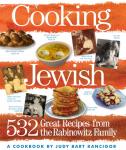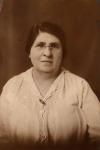
BUY COOKING JEWISH by clicking here now.
Got matzoh?
The festival of Passover, which begins this year at sundown on Wednesday, commemorates the exodus of the Hebrew slaves from Egypt. Because in their haste to depart they could not wait for their bread to rise, the dough was baked in flat cakes. To commemorate our passage to freedom, Jews throughout the world eat matzo for the eight-day holiday (seven in Israel). Strict rabbinical rules govern every aspect of its production.
“Our process with our Passover matzoh,” explained David Rossi, vice-president of marketing for RAB Food Group, owners of the Manischewitz brand, “from the time water touches the flour and gets mixed, then sheeted, made thinner and thinner, to the end of baking in the oven – can be no longer than 18 minutes. If there is a mechanical failure or some issue or error where the matzoh did not get through that run in 18 minutes, then the whole run must be thrown away.”
Before the company can begin production for Passover, the entire facility must be thoroughly cleaned and inspected – a procedure that makes Mama Hinda’s routine seem like a light dusting.
“The process takes four to seven weeks,” Rossi noted. “All the belts, all the lines, all the motors, all the ovens are cleaned and kashered (made kosher) to meet strict rabbinical standards for Passover.”
Turning out hundreds of Passover items, in addition to 10 varieties of matzo – spelt is Manischewitz’s new flavor this year – is no overnighter. “We begin making Passover products in September until early March for the following year,” Rossi noted. “Because the plant is kashered at tremendous expense, we produce Passover products until we’ve run all the requirements for the year. Then in March we start making non-Passover products.”
During the Seder we call matzo the “bread of affliction,” but that misses the real point of the holiday. Most of all Passover is the story of freedom. In retelling the Passover story, each of us relives the exodus as if we ourselves were there. To focus on what we do without for those eight days is to see the glass half empty.
Yes, we eat matzo, the poor bread that sustained our ancestors in the desert, but because we were liberated, we are free to use our ingenuity, skill, traditions and collective memory to create a glorious celebration around it.
Challenge breeds creativity, and imaginative Jewish cooks through the ages, like a million Iron Chefs all working with the same surprise ingredient, have molded, crumbled, whipped, layered, fried, baked, infused and combined matzo and its ground cousins with an astonishing variety of other ingredients to produce a tempting feast. The fact that we base a banquet on the “bread of affliction” illustrates that we have the freedom to do so.
During the Seder, we eat matzo with haroset, the fruit and nut mixture resembling the mortar the ancient Hebrews used as slaves in Egypt. Ground matzo, known as matzo meal, combines with eggs and oil to produce the feathery soup dumplings every Jewish mama’s cooking is known for: matzo balls.
Any lingering thoughts on the restrictions of Passover are quickly dispelled by dessert. Matzo ground even finer into matzo cake meal underpins the stunning display to bring a sweet end to our sweet celebration of freedom. Chag sameach! (Happy holiday!)
RECIPES
PERSIAN HAROSET
Yield: 5 cups
1 unpeeled pear, cored and finely chopped
1 unpeeled apple, cored and finely chopped
1 cup finely chopped walnuts
1 cup finely chopped almonds
1 cup finely chopped hazelnuts
1 cup finely chopped pistachio nuts
1 cup chopped pitted dates
1 cup chopped raisins
2 teaspoons ground cinnamon
2 teaspoons grated ginger
1 tablespoon apple cider vinegar
Sweet wine
1. Combine pear, apple, walnuts, almonds, hazelnuts, pistachio nuts, dates, and raisins in a large bowl and blend well, being careful not to chop the mixture into a paste. Add cinnamon, ginger, cider vinegar and enough wine to bind.
2. Place on a platter and shape into a pyramind. Cover and refrigerate.
From The Hadassah Jewish Holiday Cookbook edited by Joan Schwartz Michel (Hugh Lauter Levin Associates, Inc., $29.95) contributed by Raquel Segal, Dix Hills Hadassah, New York
TRADITIONAL MATZOH BALLS
Yield: 8 large or 16 small matzo balls
2 tablespoons melted chicken fat, vegetable oil, or shortening
2 large eggs, lightly beaten
1/2 cup matzoh meal
1 teaspoon salt, or to taste
2 tablespoons chicken stock or water
1. Mix fat and eggs together in a small bowl. Add matzoh meal and salt and blend well. Add stock or water and mix thoroughly. Cover and refrigerate until firm, at least 20 minutes.
2. Bring a large pot of salted water to a boil. Form the mixture into balls with wet hands and carefully drop into boiling water. Cover pot and cook at a steady, not hard boil until soft, 30 to 40 minutes.
3. Have soup at room temperature or warmer and transfer matzo balls to soup pot. When ready to serve, allow soup to simmer for about five minutes.
Adapted from “The Manischewitz Passover Cookbook” by Deborah Ross (Walker & Company)
BROWNED BUTTER STRAWBERRY TART
Serves 6 to 8
For the crust:
2 cups matzo cake meal
2/3 cup sugar
1 teaspoon kosher-for Passover vanilla (see Cook’s notes)
10 tablespoons cold butter, cut into tablespoon-size pieces
2 large egg yolks
2 to 4 tablespoons water
For the filling:
4 tablespoons (1/2 stick) unsalted butter
2 large eggs, room temperature
3/4 cup sugar
2 tablespoons matzo cake meal
2 tablespoons potato starch
For the topping:
3 cups fresh strawberries
1/4 cup currant jelly or strained strawberry preserves
1 tablespoon blackberry Passover wine
Cook’s notes: You can find Passover vanilla at Orange County Kosher Market in Tustin. (714) 838-3108, or use homemade vanilla sugar: Scrape seeds from 1 vanilla bean, and place both seeds and bean into 1 pound sugar. Let the sugar absorb flavor for a couple of days, and then use in recipes in place of regular sugar.
1. Preheat oven to 450oF.
2. For the crust: Process cake meal and sugar in a food processor until well blended. Add butter and pulse until cut into pea-size pieces.
3. Combine egg yolks, 2 tablespoons water, and extract, if using, in a measuring cup with a spout. With the processor running, pour eggs through feed tube and process until dough starts to clump together, 10 seconds. Dough should feel neither sticky nor crumbly. If necessary, add 1 teaspoon of water at a time and pulse 10 seconds.
4. Turn dough out onto waxed paper and gather it into a ball. Wrap in plastic wrap and refrigerate at least 15 minutes.
5. For the filling: Melt the butter in a small saucepan on high heat, stirring, until it turns golden brown. Remove from heat, strain and set aside to cool.
6. Whisk eggs, gradually adding sugar. Stir in the cake meal, potato starch and cooled browned butter.
7. Scrape filling into crust, place on a cookie sheet and bake on middle oven shelf for 5 minutes. Reduce temperature to 325oF and continue baking until firm, about 40 to 50 minutes. This can be prepared up to 8 hours ahead. Do not remove rim, and store at room temperature.
8. For the topping, up to 3 hours before serving, arrange berries atop tart. Heat jelly with wine until jelly melts, and brush over berries. Remove the rim just before serving. (When cutting through the tart, place a finger on the back of the edge as counter-pressure to avoid cracking.
From “Passover Desserts” (Wiley $16.95) by Penny W. Eisenberg

